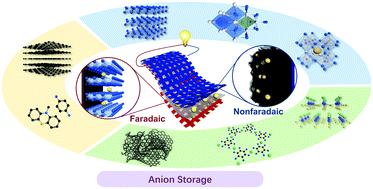Emerging trends in anion storage materials for the capacitive and hybrid energy storage and beyond
Abstract
Electrochemical capacitors charge and discharge more rapidly than batteries over longer cycles, but their practical applications remain limited due to their significantly lower energy densities. Pseudocapacitors and hybrid capacitors have been developed to extend Ragone plots to higher energy density values, but they are also limited by the insufficient breadth of options for electrode materials, which require materials that store alkali metal cations such as Li+ and Na+. Herein, we report a comprehensive and systematic review of emerging anion storage materials for performance- and functionality-oriented applications in electrochemical and battery-capacitor hybrid devices. The operating principles and types of dual-ion and whole-anion storage in electrochemical and hybrid capacitors are addressed along with the classification, thermodynamic and kinetic aspects, and associated interfaces of anion storage materials in various aqueous and non-aqueous electrolytes. The charge storage mechanism, structure–property correlation, and electrochemical features of anion storage materials are comprehensively discussed. The recent progress in emerging anion storage materials is also discussed, focusing on high-performance applications, such as dual-ion- and whole-anion-storing electrochemical capacitors in a symmetric or hybrid manner, and functional applications including micro- and flexible capacitors, desalination, and salinity cells. Finally, we present our perspective on the current impediments and future directions in this field.



 Please wait while we load your content...
Please wait while we load your content...
